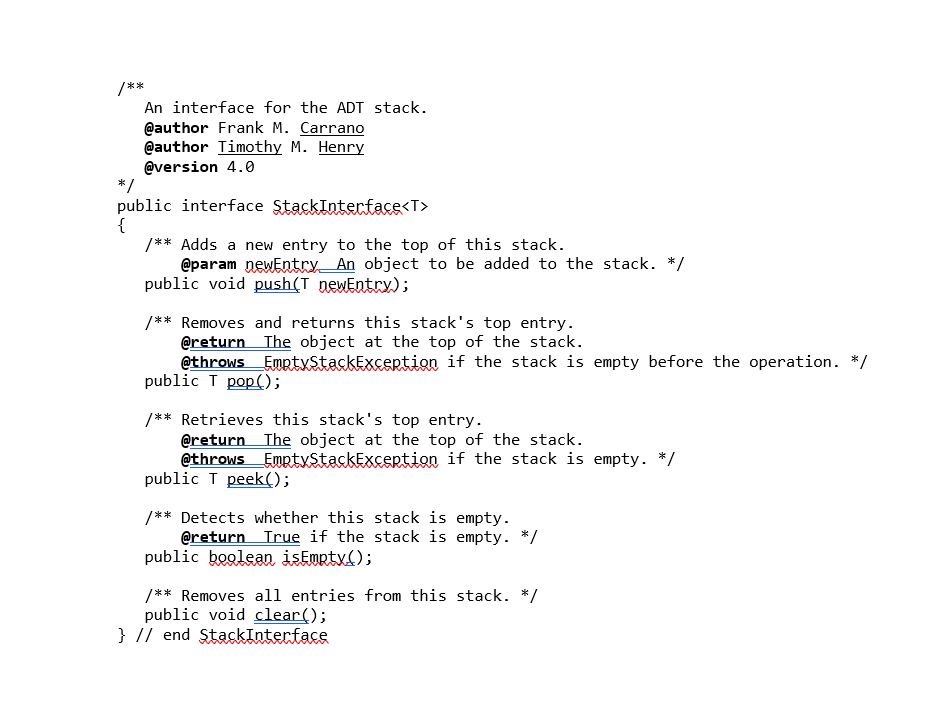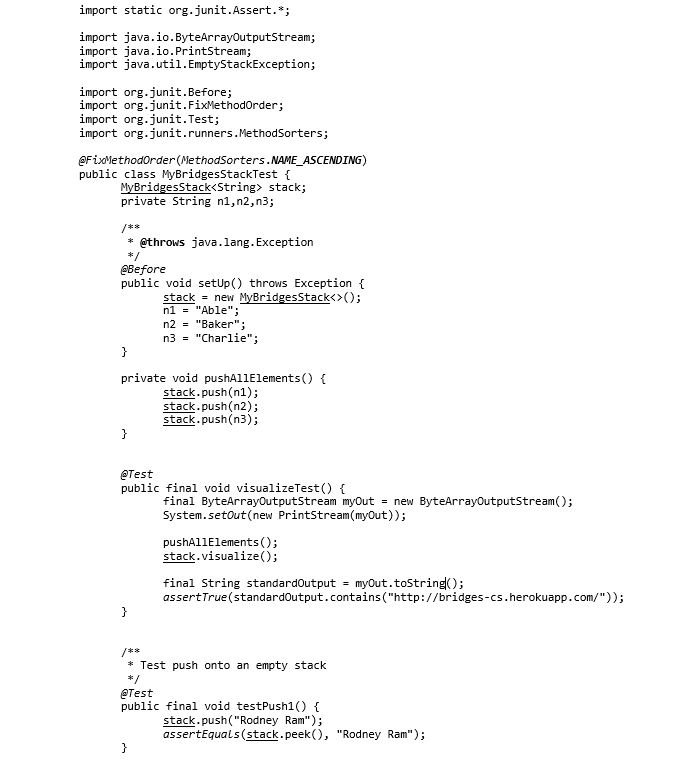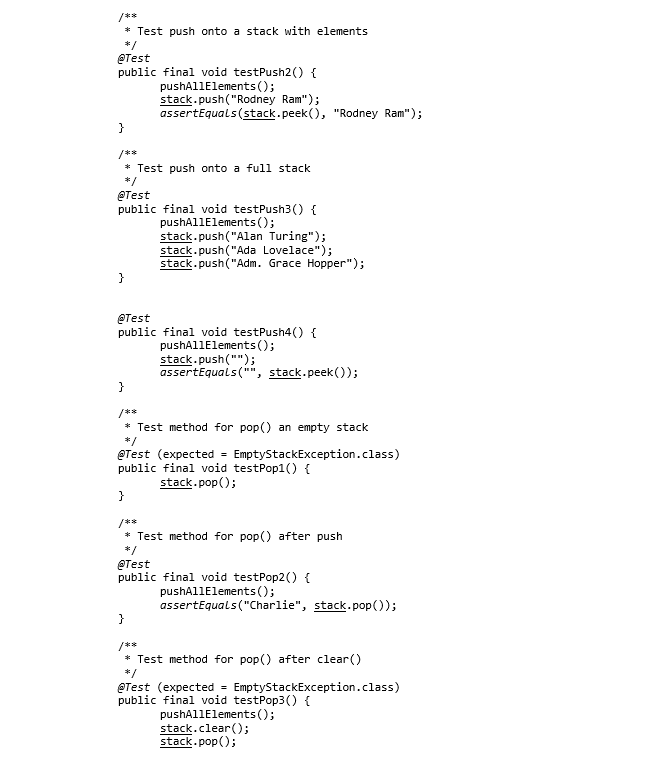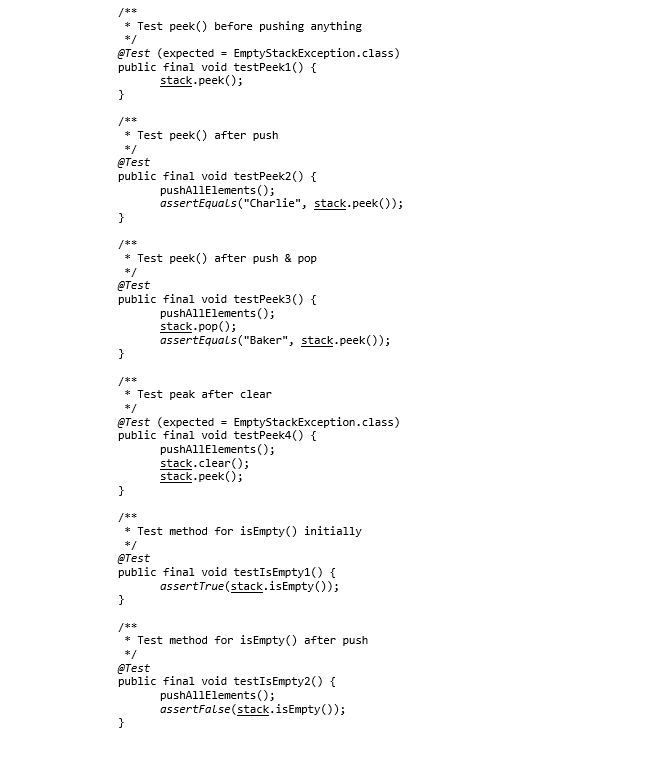Use the BRIDGES SLelement class, instead of the MyNode class. This class is named MyBridgesStack. Along with all methods defined in StackInterface, MyBridgesStack must implement a public void method named visualize. The visualize method produces a BRIDGES URL and should be used to generate BRIDGES visualizations. How would I implement the visualize method?
StackInterface attached as well as MyBridgesTester. Thanks.





An interface for the ADT stack @author Frank M. Carrano @author Timothy M. Henry @version 4.0 public interface StackIntertace
Adds a new entry to the top of this stack @param newEntryAn object to be added to the stack. */ public void push(T newEntry); Removes and returns this stack's top entry. @returnThe object at the top of the stack. @throws if the stack is empty before the operation. */ public T pop(); /**Retrieves this stack's top entry @returnThe object at the top of the stack. @throwsEmptyStackExceptign if the stack is empty. */ public T peek(); /**Detects whether this stack is empty. public boolean isEmpty(); @ret if the stack is empty. */ Removes all entries from this stack. */ public void clear(); } // end StackInterface import static org.junit.Assert.* import java.io.ByteArrayOutputStream; import java.io.PrintStream; import java.util.EmptyStackException; import org.junit.Before; import org.junit.FixMethodorder; import org.junit.Test; import org.junit.runners.MethodSorters; @FixlethodOrder (MethodSorters. NAME ASCENDING) public class MyBridgesStackTest 1 MyBridgesStack stack; private String nl,n2,n3; * @throws java.lang.Exception @Before public void setUp) throws Exception i stacknew MyBridgesStack); n1"Able"; n2"Baker"; n3"Charlie"; private void pushAllElements)f stack.push (n1); stack.push (n2); stack.push (n3); eTest public final void visualizeTest) final ByteArrayOutputStream myOut - new ByteArrayOutputStream); System.setOut (new PrintStream(myOut)); pushA1lElements(); stack.visualize) final String standardOutput-myOut.toString); assertTrue(standardoutput.contains ("http://bridges-cs.herokuapp.com/")); * Test push onto an empty stack eTest public final void testPush1) [ stack.push("Rodney Ram"): assertEquals (stack.peek(), "Rodney Ram") * Test push onto a stack with elements eTest public final void testPush2) pushA1lElements(); stack.push("Rodney Ram"): assertEquals (stack.peek(), "Rodney Ram") * Test push onto a full stack Test public final void testPush3) pushA1lElements(); stack.push("Alan Turing"); stack.push( "Ada Lovelace"); stack.push("Adm. Grace Hopper") eTest public final void testPush4) pushA1lElements(); stack.push(""); assertEquals("", stack.peek )) * Test method for pop) an empty stack eTest (expected -EmptyStackException.class) public final void testPop1) f stack.pop O; * Test method for pop) after push eTest public final void testPop2) pushA1lElements(); assertEquals("Charlie", stack.pop)); * Test method for pop() after clear() @Test (expected EmptyStackException.class) public final void testPop3) f pushA1lElements(); stack.clear: stack.pop); * Test peek() before pushing anything eTest (expected -EmptyStackException.class) public final void testPeek1) f stack.peek); * Test peek() after push eTest public final void testPeek2) pushA1lElements(); assertEquals("Charlie", stack.peek)) * Test peek() after push & pop eTest public final void testPeek3) pushA1lElements(); stack.pop); assertEquals( "Baker", stack.peek)) * Test peak after clear @Test (expected EmptyStackException.class) public final void testPeek4) pushA1lElements(); stack.clear: stack.peek); * Test method for isEmpty) initially eTest public final void testIsEmpty1) assertTrue(stack.isEmpty()): * Test method for isEmpty) after push eTest public final void testIsEmpty2) pushA1lElements(); assertFalse(stack.isEmpty)): * Test method for isEmpty) after push & pop eTest public final void testIsEmpty3) pushA1lElements(); stack.pop); assertFalse(stack.isEmptyO); * Test method for isEmpty) after push & pops eTest public final void testIsEmpty4) pushA1lElements(); stack.pop); stack.pop); stack.pop); assertTrue(stack.isEmpty)) * Test method for isEmpty) after clear eTest public final void testIsEmpty5) pushA1lElements(); stack.clear: assertTrue(stack.isEmpty)) * Test method for clear() after initialization eTest public final void testClear10 stack.clear: assertTrue(stack.isEmpty)) * Test method for clear() after pushing eTest public final void testClear2) pushA1lElements(); stack.clear: assertTrue(stack.isEmpty)) An interface for the ADT stack @author Frank M. Carrano @author Timothy M. Henry @version 4.0 public interface StackIntertace Adds a new entry to the top of this stack @param newEntryAn object to be added to the stack. */ public void push(T newEntry); Removes and returns this stack's top entry. @returnThe object at the top of the stack. @throws if the stack is empty before the operation. */ public T pop(); /**Retrieves this stack's top entry @returnThe object at the top of the stack. @throwsEmptyStackExceptign if the stack is empty. */ public T peek(); /**Detects whether this stack is empty. public boolean isEmpty(); @ret if the stack is empty. */ Removes all entries from this stack. */ public void clear(); } // end StackInterface import static org.junit.Assert.* import java.io.ByteArrayOutputStream; import java.io.PrintStream; import java.util.EmptyStackException; import org.junit.Before; import org.junit.FixMethodorder; import org.junit.Test; import org.junit.runners.MethodSorters; @FixlethodOrder (MethodSorters. NAME ASCENDING) public class MyBridgesStackTest 1 MyBridgesStack stack; private String nl,n2,n3; * @throws java.lang.Exception @Before public void setUp) throws Exception i stacknew MyBridgesStack); n1"Able"; n2"Baker"; n3"Charlie"; private void pushAllElements)f stack.push (n1); stack.push (n2); stack.push (n3); eTest public final void visualizeTest) final ByteArrayOutputStream myOut - new ByteArrayOutputStream); System.setOut (new PrintStream(myOut)); pushA1lElements(); stack.visualize) final String standardOutput-myOut.toString); assertTrue(standardoutput.contains ("http://bridges-cs.herokuapp.com/")); * Test push onto an empty stack eTest public final void testPush1) [ stack.push("Rodney Ram"): assertEquals (stack.peek(), "Rodney Ram") * Test push onto a stack with elements eTest public final void testPush2) pushA1lElements(); stack.push("Rodney Ram"): assertEquals (stack.peek(), "Rodney Ram") * Test push onto a full stack Test public final void testPush3) pushA1lElements(); stack.push("Alan Turing"); stack.push( "Ada Lovelace"); stack.push("Adm. Grace Hopper") eTest public final void testPush4) pushA1lElements(); stack.push(""); assertEquals("", stack.peek )) * Test method for pop) an empty stack eTest (expected -EmptyStackException.class) public final void testPop1) f stack.pop O; * Test method for pop) after push eTest public final void testPop2) pushA1lElements(); assertEquals("Charlie", stack.pop)); * Test method for pop() after clear() @Test (expected EmptyStackException.class) public final void testPop3) f pushA1lElements(); stack.clear: stack.pop); * Test peek() before pushing anything eTest (expected -EmptyStackException.class) public final void testPeek1) f stack.peek); * Test peek() after push eTest public final void testPeek2) pushA1lElements(); assertEquals("Charlie", stack.peek)) * Test peek() after push & pop eTest public final void testPeek3) pushA1lElements(); stack.pop); assertEquals( "Baker", stack.peek)) * Test peak after clear @Test (expected EmptyStackException.class) public final void testPeek4) pushA1lElements(); stack.clear: stack.peek); * Test method for isEmpty) initially eTest public final void testIsEmpty1) assertTrue(stack.isEmpty()): * Test method for isEmpty) after push eTest public final void testIsEmpty2) pushA1lElements(); assertFalse(stack.isEmpty)): * Test method for isEmpty) after push & pop eTest public final void testIsEmpty3) pushA1lElements(); stack.pop); assertFalse(stack.isEmptyO); * Test method for isEmpty) after push & pops eTest public final void testIsEmpty4) pushA1lElements(); stack.pop); stack.pop); stack.pop); assertTrue(stack.isEmpty)) * Test method for isEmpty) after clear eTest public final void testIsEmpty5) pushA1lElements(); stack.clear: assertTrue(stack.isEmpty)) * Test method for clear() after initialization eTest public final void testClear10 stack.clear: assertTrue(stack.isEmpty)) * Test method for clear() after pushing eTest public final void testClear2) pushA1lElements(); stack.clear: assertTrue(stack.isEmpty))











